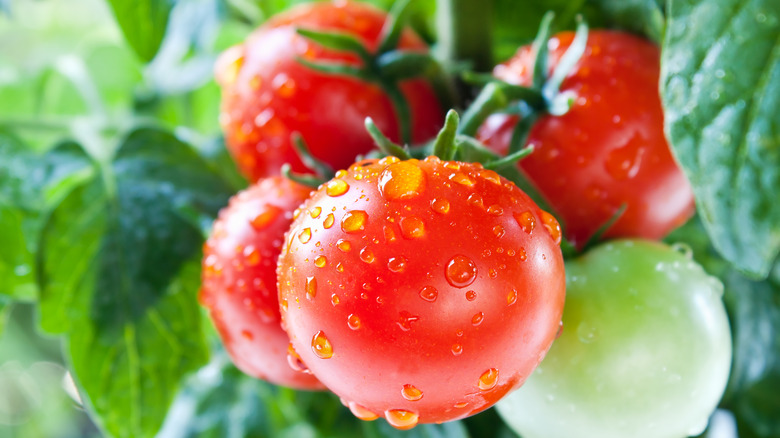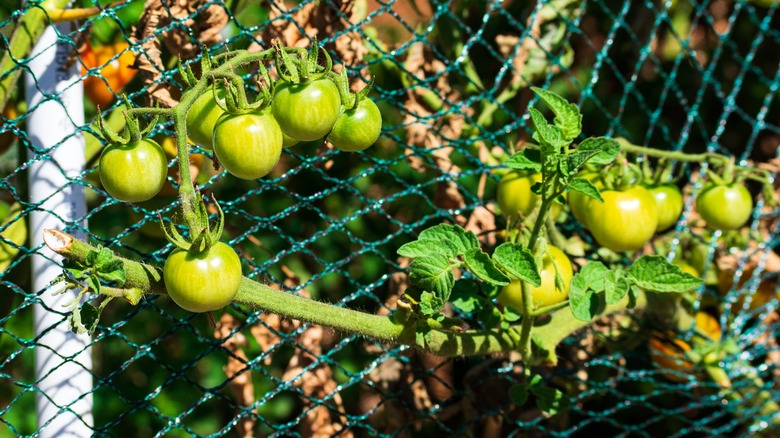Think Twice Before Using This Garden Wonder On Your Tomato Plants
When it comes to treating issues in the garden, our kitchen pantry often holds many natural, affordable, and simple solutions that are great alternatives to purchasing commercial chemicals for the same tasks. Cinnamon, for example, is a versatile aid for plant health due to its natural antimicrobial properties. It contains compounds like cinnamaldehyde, which exhibit antifungal and antibacterial effects, protecting plants from diseases. When applied to soil or directly on plant wounds, cinnamon acts as a protective barrier, preventing the growth of harmful microorganisms. This fosters a healthier environment for root development and overall plant vitality. Plant enthusiasts value cinnamon for its organic and safe characteristics, avoiding the need for chemical pesticides. This cost-effective and eco-friendly solution makes cinnamon a go-to remedy for promoting the well-being of a wide range of plants.
While cinnamon is revered for its multifaceted uses in the garden, relieving reliance on commercial chemicals, some plants do not thrive from its benevolent properties. Gardeners should avoid using cinnamon on tomato plants as it can hinder their growth and development. Cinnamon contains compounds that can irritate the sensitive tissues of tomato plants. When applied to tomatoes, it may cause leaf burn or other physiological issues, hampering the plant's ability to photosynthesize and thrive. Though cinnamon's antimicrobial properties are generally beneficial, its potential to cause stress in tomato plants makes it an unsuitable treatment. Gardeners are better off using alternative methods to support the growth of strong and healthy tomatoes.
Use Neem oil instead
While cinnamon is great for most plants, nightshades like tomatoes can often be sensitive to its effects. But neem oil is a great alternative. Derived from the seeds of the neem tree, neem oil is a natural and versatile remedy for plant care. Packed with potent compounds, neem oil is renowned for its insecticidal, antifungal, and antibacterial properties. When it comes to tomatoes, neem oil can be a game-changer in promoting their health and vigor. Neem oil acts as a potent deterrent against common tomato pests like aphids, spider mites, and whiteflies. Its natural insecticidal properties disrupt the life cycle of these pests, preventing them from causing damage to your precious tomato plants. Additionally, neem oil has antifungal qualities that can combat diseases such as powdery mildew and early blight, which are notorious for targeting tomatoes.
To apply neem oil to tomato plants, create a solution by mixing neem oil with water and a few drops of dish soap to help emulsify the oil. Use a spray bottle to evenly distribute the solution on both sides of the tomato leaves, ensuring thorough coverage. Apply the neem oil solution in the early morning or late afternoon to avoid potential leaf burn from the sun. For optimal results, apply neem oil to tomato plants every 7-14 days, especially during the growing season and when the weather is conducive to pest and disease development. Consistency is key to building a protective barrier that keeps unwanted visitors at bay.
Preventative measures for thriving tomatoes
While using products like cinnamon and neem oil are great ways to combat pests in your garden, there are preventative steps you can take that will deter them in the first place, yielding better quality tomatoes in the end. Companion planting is an effective way to prevent pests from infesting tomato plants. By strategically planting companion plants like basil, marigolds, or nasturtiums alongside tomatoes, you create a natural barrier that repels common pests. For example, basil emits aromatic compounds that can confuse and deter tomato hornworms and aphids. Marigolds release compounds that can disrupt nematode activity in the soil, protecting tomato roots. Nasturtiums act as a trap crop, attracting aphids away from tomatoes. This diversity in plantings disrupts the pest's environment, making it less attractive for them to settle and feed on tomato plants.
Implementing good garden hygiene practices is crucial in preventing pest infestations. Regularly removing debris, fallen leaves, and weeds eliminates hiding spots and breeding grounds for pests. Insects like flea beetles and caterpillars often overwinter in garden debris, and removing these hiding places disrupts their life cycle. Pruning and staking tomatoes also improve air circulation, reducing the likelihood of fungal diseases that might attract pests.
Finally, covering tomato plants with physical barriers, such as row covers or mesh netting, serves as a protective shield against pests. This method prevents insects like caterpillars, beetles, and birds from directly accessing tomato plants. It can be particularly effective for preventing damage during vulnerable growth stages.


